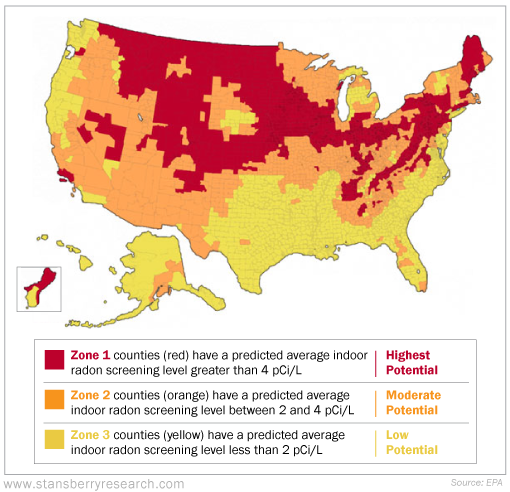You're enjoying retirement in your family home. You've worked hard for years to pay off the mortgage and you look forward to staying put.
But what you don't suspect is that something lurking in your basement has been silently killing you for years.
You can't see it or smell it... Testing is the only way to know your level of exposure.
The silent killer? Radon.
It's not a topic you hear too many people talking about. But you should, because according to the U.S. Environmental Protection Agency (EPA), it's the No. 1 cause of lung cancer among non-smokers. The National Cancer Institute estimates that about 15,000 to 20,000 lung cancer deaths per year are related to radon.
What is radon?
Radon is a naturally occurring radioactive gas that's produced by decaying uranium. It's found in soil and water, and even low levels are present in the air we breathe.
The problem occurs when radon gas enters your home through the foundation and gets trapped. Radon can get in through exposed crawl spaces, cracks in concrete slabs, construction joints, and openings around sump pumps and drains.
Long-term exposure to high levels of radon can cause cancer. Children are especially susceptible... They have faster breathing rates – ingesting the air around them more rapidly than adults. Radon gas is also heavier than oxygen, so levels are more concentrated on the floor versus the ceiling. Children tend to spend more time on the floor, playing or crawling, and playrooms are often in a home's basement. (This goes for our precious pets too... Fido spends all of his time on the ground, so he is also susceptible to the cancer-causing effects of radon.)
How do I know if my house has radon?
Since radon gas is invisible and odorless, and there are no immediate exposure symptoms, testing is the only way to know if your house has it.
The EPA recommends testing all homes for radon. The agency estimates that as many as 8 million homes throughout the country have elevated levels of radon.
The map below shows how radon levels can vary based on geographic location. It's still important to test even if you live in a low-risk area, as levels can be very different in neighboring homes. It also doesn't matter if your house is old or new, large or small.
You can test for radon yourself with a do-it-yourself ("DIY") test kit, found at your local hardware store. (Here's one from Amazon for about $14.)
The kit contains a small canister, usually charcoal-based. You place the test in your basement (or the lowest level in your home), where it just sits undisturbed for about 48 hours. Then you mail the canister to a specified, certified lab for results.
The EPA recommends fixing homes if radon levels are higher than four picocuries per liter (pCi/L).
What if my test reveals I have high levels?
First, don't panic. If your test reveals your home has elevated radon levels, you don't need to overact. Remember that the danger is from long-term exposure, and the risks are cumulative.
Contact your local EPA office so staff can provide you with a list of qualified professionals who can install a radon-mitigation system in your home. This can cost a few hundred dollars, up to $1,000.
Usually a fan is installed to direct the radon gas out of your home. Once outside, the radon naturally dissipates into the air and is no longer a problem.
I know some skilled DIY-ers who have fixed the radon problem themselves, but I don't recommend this unless you have the right tools and knowledge. You could end up making the problem even worse... Some potential issues include backdrafting (accidently pulling carbon monoxide from the furnace flue back into the house), piercing hidden pipes, and radon reentry.
Radon-reduction systems work. Some can reduce radon levels in your home by 99%. You should re-test after the mitigation system is in place, just to ensure the problem is taken care of.
What We're Reading...
- Something different: Do you have what it takes to survive a Zombie Apocalypse?
Here's to our health, wealth, and a great retirement,
Dr. David Eifrig and the Health & Wealth Bulletin Research Team
November 29, 2018

